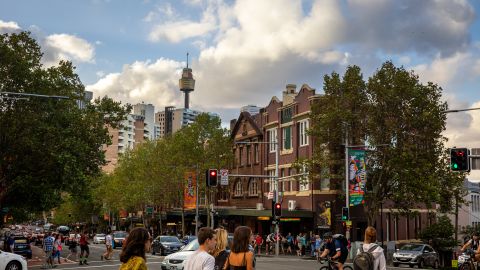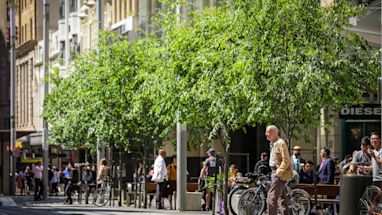If you’ve ever enjoyed the glitter and glam of Mardi Gras, danced until the early hours or whittled away an afternoon browsing the shops on Oxford Street, listen up.
We know that Oxford Street holds a special place in our city’s collective heart. From one of the oldest ‘muru’ (tracks) crossing Gadigal land, to the birthplace of Mardi Gras, it’s seen a lot. That’s why we’re looking to protect its iconic status the best way we can: through planning rules.
We’re seeking feedback from people like you on our proposed planning rules. Learn more about what they mean, why they’re so revolutionary in the world of planning and how to get involved.
Short version
Our proposed planning rules make space for culture. Under the proposal, developers would be allowed to build higher than what’s allowed now on Oxford Street. But they’d need to maintain any existing cultural space in their building and dedicate a percentage of their space to culture and creativity. That might mean for example, including a recording studio, an artist studio or a performance space.
They’d also have to make space for other uses that bring people in and support the local economy, like retail, food and drink, hotels, health, education, entertainment and community facilities. And even though we’d allow taller buildings, this plan protects the heritage buildings that give Oxford Street its unique character.
We developed this proposal based on feedback our communities gave us in late 2020.
“We’re breathing new life into the fabulous strip with innovative controls to support growth and diversity, protect heritage and character and promote both day and night-time economies – all while ensuring the development of cultural space, such as new basement entertainment and space for creatives,” said Lord Mayor Clover Moore.
What you’ve told us so far
In 2020, we consulted with the community about the future of Oxford Street. Some of that feedback included:
- 93% of people supported making Oxford Street a creative and cultural precinct
- 80% said Oxford Street held social and cultural importance to them
- 83% identified the importance of the LGBTIQ identity of Oxford Street
- 88% supported reviews of planning approaches
“The community has made it clear that we need to preserve and celebrate Oxford Street’s history as a sacred walking track for the Gadigal and the heart of Sydney’s LGBTIQ community, while safeguarding its future, particularly as we ready to welcome World Pride 2023,” said Lord Mayor Clover Moore.
“Renewing our planning rules will help reinforce Oxford Street’s creative and cultural possibilities. We're committed to building on its reputation as an iconic gay and lesbian precinct and a centre of buzzing activity both day and night, with space for thriving businesses, creatives and culture.”
Let’s get specific
The planning proposal applies to what we’re calling the Oxford Street creative precinct between Hyde Park and Greens Road in Darlinghurst. We’re also separately seeking feedback on plans for Taylor Square.

What we’re talking about when we say culture and creativity
We know the city is changing fast, and it’s made it difficult to find space for creative small businesses. We want to use these planning rules to create spaces for art and creative pursuits, especially those that can become jobs. That might mean photography, design, craft or fine art studios, live music and performance, recording studios, film and television production. The proposed controls could create more than 11,000sqm of new creative and cultural floor space. They even incentivise transforming basements into the underground venues Oxford Street needs.
But Oxford Street is struggling
Yes, absolutely. Empty shop fronts, fewer people and noisy streets. We believe with the right planning rules in place, the street can rejuvenate into a cultural hub.
These planning proposals are just one part of that process.
We’ll look to address other issues raised in consultation, including public domain improvements and operational issues such as traffic management through future projects.
Tell me more about Taylor Square
Last year we heard 2 things about Taylor Square: how special it is, especially to the LGBTIQ communities and also how underused it is. We think with the right planning decisions it could become the heart of the Oxford Street cultural and creative precinct.
One way to encourage more people to spend more time in Taylor Square is to change the planning rules to allow for taller buildings facing the square. There are a couple of main benefits to this: architectural and visual interest and more space for creativity. We’re considering allowing taller buildings in Taylor Square than the rest of Oxford Street cultural and creative precinct. You can take a look at the options and have your say.
Your voice really does matter
If you’ve read this far, you probably care about Oxford Street. You might agree with what we’ve put forward, or you might hold some concerns. Either way, we want to hear from you.
For these planning rules to succeed, we need to understand what we’ve got right, and what might go wrong if the plans are put in place. We read every comment and take your feedback on board. It really is worth taking the time to share your thoughts.
You can dig into the details of the full planning proposal and complete a short survey. The consultation is open until Friday 5 November.
You should also know
These planning controls are kind of groundbreaking. As far as we know, we’d be the first city in Australia to introduce planning rules like this. It’s pretty exciting stuff.
After the consultation closes
We’ll consider and report your feedback on the planning proposal to Council in 2022 and work with the Department of Planning, Industry and Environment to publish the new planning controls later in the year. If we make changes to Taylor Square they will be exhibited for comment later.
Published 20 September 2021, updated 11 October 2022



